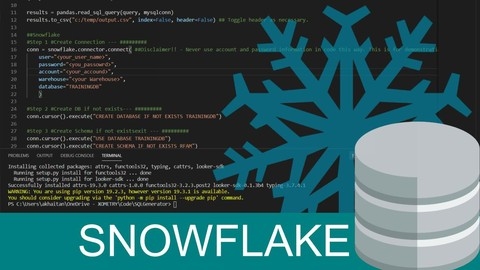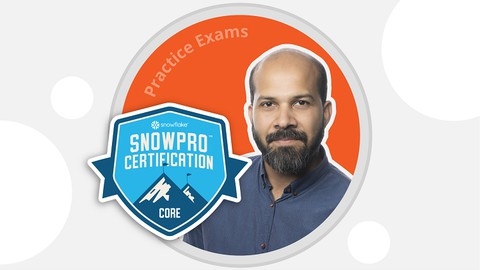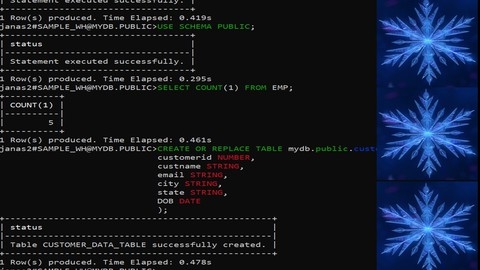Snowflake is a cloud-based data warehouse that’s gaining popularity for its scalability, performance, and ease of use.
It’s a powerful tool for data professionals who need to store, analyze, and share large volumes of data.
By mastering Snowflake, you can unlock exciting career opportunities in data warehousing, data engineering, and data analytics.
Finding the right Snowflake course on Udemy can be challenging, with so many options available.
You want a course that’s comprehensive, engaging, and taught by experts, but also fits your learning style and goals.
For the best Snowflake course overall on Udemy, we recommend Snowflake – The Complete Masterclass.
This course covers everything from the fundamentals of Snowflake architecture to advanced concepts like performance optimization, data sharing, and security.
The hands-on projects and real-world scenarios make this a great choice for both beginners and experienced learners.
While this is our top pick, there are other great options available.
Keep reading for more recommendations, tailored to different learning levels and specific goals.
We’ll also highlight courses that focus on particular Snowflake features and certifications.
Snowflake – The Complete Masterclass
The course starts with an introduction that welcomes you and outlines what you’ll learn.
You’ll get access to all the course slides and resources right from the beginning.
In the “Getting Started” section, you’ll learn how to sign up for a free trial, log in to your account, and navigate the Snowflake interface.
The course dives into the Snowflake architecture, explaining key concepts like data warehouses, cloud computing, and the different Snowflake editions and pricing.
You’ll learn how to set up warehouses using SQL and explore tables and databases.
Loading data into Snowflake is a crucial skill, and this course covers it in depth.
You’ll learn about various loading methods, stages, and the powerful COPY command.
The course also teaches you how to transform data during the loading process and handle errors using copy options like ON_ERROR and FORCE.
One of the standout sections of the course is on loading unstructured data, such as JSON and Parquet files.
You’ll learn how to create stages, parse nested JSON data, handle hierarchies, and query Parquet files efficiently.
Performance optimization is key to getting the most out of Snowflake, and this course has you covered.
You’ll learn how to create dedicated virtual warehouses, scale up and out, maximize caching, and implement clustering for faster queries.
The course also covers loading data from popular cloud platforms like AWS, Azure, and GCP.
You’ll learn how to create storage integrations, stages, and load data from S3 buckets, Azure Blob Storage, and Google Cloud Storage.
Snowpipe, Snowflake’s continuous data ingestion tool, is explained in detail.
You’ll learn how to create pipes, configure notifications, and handle errors.
The course even covers using Snowpipe with Azure.
Other advanced topics covered include Time Travel for data recovery, Fail-Safe for data protection, Zero-Copy Cloning for efficient data sharing, and Data Sharing with secure views.
You’ll also learn about data sampling techniques and how to schedule tasks using Snowflake’s task feature and CRON syntax.
The course dives into Streams for change data capture, Materialized Views for performance optimization, and Dynamic Data Masking for sensitive data protection.
Access control is thoroughly explained, covering key roles like ACCOUNTADMIN, SECURITYADMIN, SYSADMIN, and custom roles.
You’ll learn how to connect Snowflake with popular BI tools like Power BI and Tableau for data visualization.
The course also shows you how to leverage Partner Connect to integrate with ETL tools seamlessly.
Finally, the course shares best practices for virtual warehouses, table design, monitoring, and data retention to help you optimize your Snowflake implementation.
Snowflake Decoded - Master the Fundamental Concepts
The course starts with an introduction to Snowflake, covering key aspects like the different editions available and how to sign up for a trial account.
You’ll also get familiar with the Snowflake Web User Interface (UI) right from the beginning.
One of the standout features of this course is its in-depth coverage of Snowflake’s unique architecture.
You’ll learn how Snowflake’s hybrid architecture sets it apart from traditional databases, with a focus on the compute layer (virtual warehouses), storage layer (micropartitions), and cloud services layer.
The course also explains how Snowflake’s pricing model works, giving you a clear understanding of the costs involved.
To help you get hands-on experience, the course includes practical exercises on installing SnowSQL and connecting to your Snowflake instance.
You’ll learn various methods for loading data into Snowflake, such as using named internal stages, external stages, and even basic data transformations during the loading process.
The course also covers how to unload and export data from Snowflake.
Continuous data protection is a crucial aspect of any database system, and this course dedicates an entire section to it.
You’ll discover how Snowflake’s Time Travel feature allows you to query historical data and how Fail-Safe storage ensures data durability.
The hands-on exercises will guide you through using Time Travel to recover dropped tables and explore the different types of tables in Snowflake, such as temporary and transient tables.
Cloning is another powerful feature in Snowflake, and the course explains how zero-copy cloning works and provides hands-on practice for cloning tables, databases, and schemas.
You’ll also learn how to combine cloning with Time Travel for even more flexibility.
Data sharing is a key strength of Snowflake, and the course covers this topic extensively.
You’ll learn about secure data sharing options, including direct sharing with other Snowflake accounts and non-Snowflake customers.
The course also introduces you to the Snowflake Marketplace, where you can access and share pre-built datasets and data services.
Performance optimization is essential for any data professional, and this course dives deep into the subject.
You’ll gain an understanding of query execution in Snowflake and learn how to access and interpret query profiles.
The course covers various caching mechanisms, such as query result cache, metadata cache, and virtual warehouse cache, along with hands-on demonstrations.
You’ll also learn about partition pruning, clustering keys, scaling virtual warehouses, and using materialized views for performance gains.
Security and access control are critical aspects of any data platform, and Snowflake provides robust features in this area.
The course covers encryption at rest, multi-factor authentication (MFA), and the granular access control system in Snowflake.
You’ll learn about the different out-of-the-box roles and how to implement network layer security.
Snowflake offers various ways to extend its functionality, and the course explores secure user-defined functions (UDFs), stored procedures, Snowpark for using popular programming languages, and Snowflake Scripting for task automation.
Finally, the course covers resource management in Snowflake, including using resource monitors, viewing usage and billing information, and leveraging the Account Usage and Information schemas for monitoring and optimization.
Throughout the course, you’ll find quizzes to test your understanding and reinforce the concepts learned.
Snowflake[A-Z] Zero to Hero Masterclass(Core+SQL+API+Visual)
The course starts with an introduction to Snowflake, helping you create a free account and explore the different roles, databases, schemas, and tables.
You’ll dive deep into Snowflake’s architecture, learning about virtual warehouses and how they function as the compute engine.
Understanding Snowflake’s pricing model is crucial, and this course dedicates an entire section to break down the various factors that affect cost, such as credits, storage, data transfer, and more.
You’ll learn optimization methods to reduce expenses and how to set up resource monitors to track and control compute consumption.
The course then moves on to more advanced concepts like micro-partitioning and clustering, which are essential for query optimization and faster data retrieval.
You’ll learn how to leverage query history and caching to improve performance further.
Hands-on exercises are a significant part of this course.
You’ll load data from various sources like AWS S3, Microsoft Azure, and even use Snowpipe for continuous data ingestion.
The course covers different types of tables, such as temporary, permanent, and transient, and how to work with the history of objects using Time Travel and Fail Safe.
You’ll learn how to schedule queries using Tasks, track DML changes with Streams, and perform zero-copy cloning.
The course also covers secure data sharing, materialized views, secure views, and implementing row-level security.
The course dives into Snowflake SQL, covering DDL, DML, and DQL.
You’ll learn about sub-queries, case statements, set operators, and working with row numbers.
The course also introduces you to Snowflake’s Partner Connect and the various tools available.
For those interested in automation and integration, the course covers working with Snowflake’s Python API and connecting Snowflake with visualization tools like Tableau and PowerBI.
You’ll even build a minor project exposing Snowflake data through a Python API.
As a bonus, the course includes practice tests to help you prepare for the SnowPro Core Certification exam, boosting your confidence before taking the actual test.
With over 150 lectures and quizzes spanning multiple chapters, this course provides a comprehensive learning experience.
Snowflake Masterclass[stored proc+demos+Best practices+Labs]
The course begins with a high-level overview of Snowflake’s architecture, including its unique shared-nothing architecture and how it enables efficient query processing and concurrency control.
You’ll set up your Snowflake environment, create databases and tables, and explore the web console.
Next, you’ll dive into data loading techniques, learning how to load structured and unstructured data from various sources like local systems, AWS S3, Google Cloud Storage, and Azure Blob Storage.
The course covers different staging mechanisms, file formats like Parquet, and best practices for optimizing data loading performance.
With your data loaded, you’ll learn about performance tuning, clustering, and leveraging Snowflake’s query acceleration features like QAS and SOS.
The course also explores materialized views, dynamic tables, and how to handle slowly changing dimensions effectively.
Data sharing and security are key topics covered in the course.
You’ll learn how to set up secure views, reader accounts, and data masking policies to protect sensitive information.
The course also delves into access control, role hierarchies, and managing permissions at various levels.
Throughout the course, you’ll work with real-world datasets and scenarios to apply your knowledge.
Hands-on labs and challenges will reinforce your understanding of concepts like data loading, unloading, external tables, and more.
Advanced topics like stored procedures, transactions, error handling, and using Snowflake with Spark are also covered.
You’ll learn best practices for cloning, fail-safe, time travel, and disaster recovery to ensure data integrity and business continuity.
By the end of the course, you’ll have a solid foundation in Snowflake and be equipped with the skills to design, implement, and optimize Snowflake solutions for your data warehousing needs.
Snowflake for Developers
The course starts by providing a solid foundation in data warehousing concepts, including data modeling and the typical architecture of on-premises and cloud data warehouse systems.
You’ll gain an understanding of what makes Snowflake unique as a Software-as-a-Service (SaaS) offering.
Next, the course dives deep into Snowflake’s architecture, exploring its three layers: Data Storage, Virtual Warehouse, and Cloud Services.
You’ll learn how Snowflake leverages distributed computing concepts and AWS’s S3 capabilities for efficient data storage.
The course also covers important topics like caching mechanisms, file stealing processes, and the execution engine.
Through hands-on demonstrations, you’ll become familiar with Snowflake’s web interface and learn how to create a trial account.
The course discusses Snowflake’s editions, pricing model, and key features such as stages, file formats, sequences, and security basics.
You’ll gain practical skills in loading data into Snowflake using Python code and performing data transformations using Snowflake’s powerful Extract, Load, and Transform (ELT) capabilities.
The course also teaches you how to consume data from Snowflake for analytical purposes using purpose-built connectors, JDBC drivers, and ODBC drivers.
You’ll explore Snowflake’s special features, including Snowpipes for auto-ingestion, Time Travel for data recovery, and the SnowSQL command-line interface (CLI).
One of the highlights of the course is its coverage of Snowflake’s data sharing capabilities.
You’ll learn about the importance of data sharing, its limitations, and how to set it up effectively.
The course also discusses reader accounts and their role in data sharing.
Throughout the course, you’ll have the opportunity to test your knowledge with quizzes and reinforce your understanding of Snowflake’s architecture and features.
You’ll be equipped with the skills and knowledge needed to work with Snowflake effectively in your day-to-day job functions, whether it’s loading data, performing transformations, or consuming data for analysis.
Snowflake SnowPro Core Certification Practice Tests COF-C02
This course is designed to test your knowledge and identify areas for improvement through a series of six practice exams.
Each practice exam draws from a pool of approximately 550 questions, ensuring that you get a diverse and challenging set of questions to work through.
While the exact wording and format may differ from the actual SnowPro Core exam, these practice questions are carefully crafted to cover the key topics and concepts you need to master.
As you progress through the practice exams, you’ll gain confidence in your understanding of Snowflake’s features, architecture, and best practices.
The questions are designed to be thought-provoking and to encourage you to apply your knowledge in real-world scenarios.
One of the standout features of this course is the instructor’s commitment to keeping the content up-to-date.
Snowflake is a rapidly evolving platform, and the SnowPro Core exam is continuously updated to reflect the latest changes.
If you come across a topic that you feel should be included in the practice exams, simply reach out to the instructor, and they will promptly add it to the question pool.
By the time you complete all six practice exams, you’ll have a solid grasp of the key concepts covered in the SnowPro Core exam.
You’ll be well-prepared to tackle questions on Snowflake’s architecture, data loading, query optimization, security, and more.
[COF-C02] Snowflake SnowPro Core Certification Practice Sets
This course offers a series of full-length mock exams and focused revision practice sets designed to simulate the actual certification exam experience.
The course includes three full practice sets, each containing 100 multiple-choice and multiple-select questions covering all the essential subject areas of the SnowPro Core Certification.
These areas include Snowflake Cloud Data Platform Features and Architecture, Account Access and Security, Performance Concepts, Data Loading and Unloading, Data Transformations, and Data Protection and Data Sharing.
With a time limit of 115 minutes per mock exam and a passing score of 75%, these practice sets closely mirror the format and difficulty of the real certification exam.
In addition to the full practice sets, the course also provides three targeted revision practice sets, each focusing on specific subject areas.
The “Architecture & Data Protection and Sharing” set contains 105 questions and allows 120 minutes for completion.
The “Access and Security & Performance Concepts” set also has 105 questions and a 120-minute time limit.
Lastly, the “Data Loading and Unloading & Transformations” set consists of 90 questions with a 104-minute time limit.
These revision sets are perfect for reinforcing your knowledge in key areas and identifying any gaps in your understanding.
By working through the mock exams and revision sets, you’ll gain valuable hands-on experience with the types of questions you can expect on the actual certification exam.
The course provides a realistic testing environment, allowing you to assess your readiness and build confidence in your ability to pass the SnowPro Core Certification.
Snowflake SnowPro Core Certification Preparation - COF-C02
The course is structured to cover all the key domains and topics you need to master to pass the exam and become a certified Snowflake professional.
The course starts with an introduction to Snowflake, its editions, and a hands-on exercise to create your first database and table.
You’ll explore the Snowflake Web UI and understand its various sections.
Next, you’ll dive deep into Snowflake’s unique hybrid architecture, which sets it apart from traditional database architectures.
You’ll learn about the compute layer (virtual warehouses), storage layer (micro-partitions), and the critical cloud services layer that acts as the brain of the operations.
The course explains how query execution and caching work in Snowflake, and covers Snowflake’s pricing model.
Moving on, you’ll discover the various ways to connect to Snowflake, including drivers, connectors, and the Web UI.
You’ll install SnowSQL and practice connecting to your Snowflake instance.
Data loading is a crucial aspect of working with Snowflake, and this course dedicates an entire section to it.
You’ll learn about stages (external, internal, table, and user), loading data from on-premises via internal stages, external tables, unloading data, and basic data transformations.
The course also covers Snowpipe for continuous data ingestion.
Snowflake offers powerful features for data protection and management, such as Time Travel, Fail-safe, and Cloning.
You’ll learn how these features work, their costs, and practice using them through hands-on exercises.
The course also explains the different types of tables in Snowflake (temporary and transient).
Data sharing is another key capability of Snowflake, and the course explores how it works, the different offerings (Direct Sharing, Snowflake Marketplace, Data Exchange), and provides hands-on practice with sharing data.
To optimize performance, you’ll learn about query execution, caching (query result, metadata, and virtual warehouse), clustering keys, partition pruning, scaling virtual warehouses, materialized views, and the Search Optimization Service.
Security is a top priority in Snowflake, and the course covers various aspects such as data encryption at rest, multi-factor authentication (MFA), key-pair authentication, single sign-on (SSO), access control (RBAC and DAC), network policies, and system roles.
The course also explores ways to extend Snowflake’s functionality through secure user-defined functions (UDFs), stored procedures, Snowpark, and Snowflake scripting.
Finally, you’ll learn about account and resource management, including resource monitors, usage and billing views, the account usage schema, information schema, and Snowflake’s release process.
To reinforce your learning and identify areas for improvement, the course includes quizzes throughout and two comprehensive mock exams with over 100 questions each, closely mimicking the actual SnowPro Core Certification exam.
By the end, you’ll have a solid understanding of Snowflake’s architecture, features, and best practices, and be well-prepared to ace the certification exam and apply your knowledge in real-world scenarios.
Snowflake Certification: SnowPro Core COF-C02 Exam Prep
The course starts with an introduction to Snowflake, including how to set up a free trial account, navigate the Snowsight interface, and load a sample database.
You’ll then dive into the fundamental Snowflake architecture, learning about its multi-cluster shared-disk design and the three distinct layers that make it so powerful and scalable.
Next, you’ll explore the different Snowflake Editions and learn how to monitor and control costs related to storage, data transfer, and compute resources.
The course also covers key Snowflake objects, how to use SnowSQL, and best practices for creating and managing warehouses.
A significant portion of the course is dedicated to data loading and unloading.
You’ll learn about internal and external stages, how to use the COPY INTO command for bulk loading, and how to work with different file formats.
The hands-on exercises will guide you through loading semi-structured data like JSON, querying it effectively, and even flattening hierarchical data structures.
The course also explores data transformation techniques, including using SQL functions, UDFs, stored procedures, and external functions.
You’ll learn how to work with sequences, secure UDFs, and handle unstructured data using directory tables.
To ensure your data is protected, the course covers Snowflake’s Continuous Data Protection features like Time Travel, which allows you to query historical data, and Fail Safe, which provides an extra layer of protection against accidental data loss.
You’ll also learn about zero-copy cloning and secure data sharing, enabling seamless collaboration without data movement.
Security is a critical aspect of any data platform, and this course has you covered.
You’ll learn about access control in Snowflake, how to manage roles and privileges, and implement column-level and row-level security.
The course also covers authentication methods like multi-factor authentication and SSO, network policies, and data encryption.
Throughout the course, you’ll find quizzes to test your understanding and reinforce key concepts.
The hands-on exercises provide practical experience with tasks like creating resource monitors, working with stages, loading data using COPY INTO, and configuring access control.
By the end of the course, you’ll have a solid grasp of performance optimization techniques like caching, clustering, and materialized views.
You’ll be well-prepared to tackle the final practice exam, which simulates the actual certification exam format and difficulty.
Snowflake Complete Course for Clearing Interviews
You’ll start with an introduction to Snowflake, learning how to get started, access resources like PPTs and queries, and gain an overview of the architecture and virtual warehouses.
Next, you’ll dive into creating a trial account and exploring the intuitive Snowflake web UI.
The course covers essential topics like micro partitions, clustering, data loading, and transforming data within Snowflake.
You’ll learn about stages, including external stages, internal stages, and how to use SnowSQL for efficient data management.
The course also explores integrations with popular cloud platforms.
You’ll discover how to seamlessly integrate Snowflake with AWS and Azure, enabling you to load data from Azure containers directly into Snowflake tables.
Additionally, you’ll gain expertise in processing semi-structured data formats like JSON, XML, and Parquet.
Understanding Snowflake’s pricing model is crucial, and this course breaks down the cost calculation process.
You’ll learn about Snowpipe for continuous data ingestion and troubleshooting techniques to ensure smooth data flow.
The course also covers advanced features like caching, Time-Travel, Fail-Safe, and zero-copy cloning, empowering you to optimize performance and ensure data integrity.
To secure your data, the course delves into role-based access control, teaching you how to create roles and users with appropriate permissions.
You’ll explore views, materialized views, and dynamic data masking to control data access and protect sensitive information.
Data sharing capabilities are also covered, enabling you to securely share data with external parties.
The course goes beyond basic data management by introducing tasks for scheduling, streams for change data capture (CDC), and data unloading techniques.
You’ll learn about data sampling, external tables, and how to extend Snowflake’s functionality using user-defined functions (UDFs) and stored procedures written in SQL and JavaScript.
Monitoring and alerting are essential for any data platform, and this course covers Snowflake alerts and email notifications to keep you informed about important events.
You’ll also learn how to deploy and migrate code using GitHub and Schema Change, ensuring smooth development workflows.
Resource monitors help you track credit usage and optimize costs, and the course provides a detailed explanation of how to set them up.
Finally, you’ll be well-prepared for Snowflake interviews with a collection of common questions and scenario-based challenges.



![Snowflake[A-Z] Zero to Hero Masterclass(Core+SQL+API+Visual)](/img/best-snowflake-courses-udemy/3463886_SnowflakeA-ZZerotoHeroMasterclassCoreSQLAPIVisual.jpg)
![Snowflake Masterclass[stored proc+demos+Best practices+Labs]](/img/best-snowflake-courses-udemy/2209466_SnowflakeMasterclassstoredprocdemosBestpracticesLabs.jpg)


![[COF-C02] Snowflake SnowPro Core Certification Practice Sets](/img/best-snowflake-courses-udemy/3573825_COF-C02SnowflakeSnowProCoreCertificationPracticeSets.jpg)


